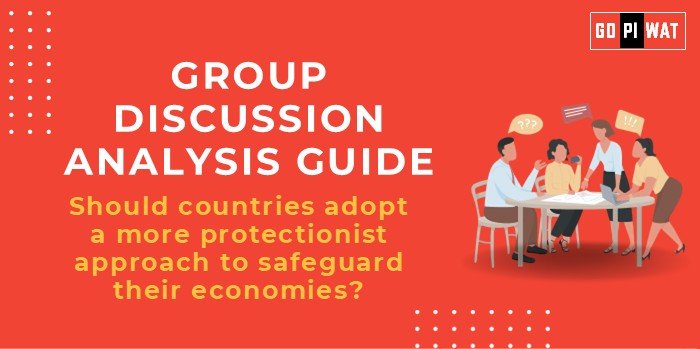📋 Group Discussion (GD) Analysis Guide
🌍 Topic: Should Countries Adopt a More Protectionist Approach to Safeguard Their Economies?
📖 Introduction to the Topic
- 💡 Opening Context: With globalization facing new headwinds post-COVID-19, debates around protectionism versus free trade have intensified. Economic challenges, supply chain disruptions, and rising nationalism are driving countries to rethink their strategies.
- 📜 Topic Background: Protectionism refers to economic policies like tariffs, quotas, and subsidies aimed at shielding domestic industries from international competition. Historical examples include U.S. trade policies during the Great Depression and China’s modern industrial strategy. Recently, the U.S.-China trade war and the pandemic have reignited these discussions.
📊 Quick Facts and Key Statistics
- 📈 Global Tariff Trends: Average global tariffs have risen to 7.6% in 2023 from 6.8% in 2019 (World Bank).
- 🔄 Supply Chain Relocation: 70% of companies surveyed in 2023 reported plans to diversify supply chains away from China (McKinsey).
- 📉 Trade Growth Slump: Global trade growth is forecasted at 1.7% for 2024, compared to 4% pre-pandemic (WTO).
- 🌎 Rising Nationalism: Over 50 countries implemented trade-restrictive measures in 2023 (UNCTAD).
🌍 Stakeholders and Their Roles
- 🏛️ Governments: Shape trade policies to protect key industries, often in response to domestic pressures.
- 🌐 Global Organizations: WTO and IMF promote multilateral trade frameworks but face challenges from rising unilateral measures.
- 💼 Businesses: Seek stable trade environments but adapt strategies like reshoring or nearshoring amid policy changes.
- 👥 Citizens: Gain job protection but face higher costs of goods due to limited imports.
🏆 Achievements and Challenges
✨ Achievements
- 👷 Job Creation: Tariffs on steel in the U.S. saved approximately 1,500 jobs in 2022.
- 🏭 Industrial Growth: India’s Production-Linked Incentive (PLI) scheme attracted $20 billion in 2023.
- 🔄 Supply Chain Resilience: Japan’s “China+1” strategy mitigated pandemic-related disruptions.
⚠️ Challenges
- 📉 Economic Inefficiencies: Studies show protectionism reduces GDP by up to 1.9% in the long term (OECD).
- ⚡ Retaliatory Trade Wars: The U.S.-China tariff conflict reduced global trade by $1.5 trillion between 2018 and 2022.
- 📈 Consumer Costs: Higher tariffs on imports led to a 7% rise in consumer goods prices globally (IMF, 2023).
🌏 Global Comparisons
- ✔️ Success: Germany balances industrial protection with global competitiveness through innovation subsidies.
- ❌ Failures: Argentina’s import restrictions contributed to hyperinflation.
📚 Case Study
- 🇮🇳 India’s Tariff Hikes (2018-2023): Aimed at bolstering “Make in India,” they spurred growth in electronics manufacturing but strained relations with trading partners.
💡 Structured Arguments for Discussion
- ✔️ Supporting Stance: “Protectionism safeguards local industries, reducing dependency on volatile global markets.”
- ❌ Opposing Stance: “Trade barriers create inefficiencies, hurting economic growth and international cooperation.”
- ⚖️ Balanced Perspective: “Strategic protectionism can support emerging industries but must be complemented with global partnerships.”
📈 Effective Discussion Approaches
- 🗣️ Opening Approaches:
- 💬 Begin with global statistics on rising tariffs.
- 📚 Highlight a relevant case study, like the U.S.-China trade war.
- 🔄 Counter-Argument Handling: Acknowledge opposing views: “While it’s true that protectionism secures jobs, evidence suggests it often reduces long-term competitiveness.”
🔍 Strategic Analysis of Strengths and Weaknesses
- 💪 Strengths: Encourages local production. Reduces foreign dependency.
- ⚠️ Weaknesses: Can lead to inefficiency. Often provokes retaliatory measures.
- 🚀 Opportunities: Promotes innovation through government support. Creates regional supply chains.
- ⚡ Threats: Risks of isolationism. Slower global economic recovery.
🎓 Connecting with B-School Applications
📚 Real-World Applications
Explore case studies of protectionist policies for operations and trade strategy projects.
📋 Sample Interview Questions
- 💬 “What are the long-term impacts of protectionism on global trade?”
- 💬 “Discuss the role of protectionism in driving innovation.”
💡 Insights for B-School Students
- 📖 Analyze trade-offs in economic policies.
- 🌍 Link concepts to global trade and finance modules.


